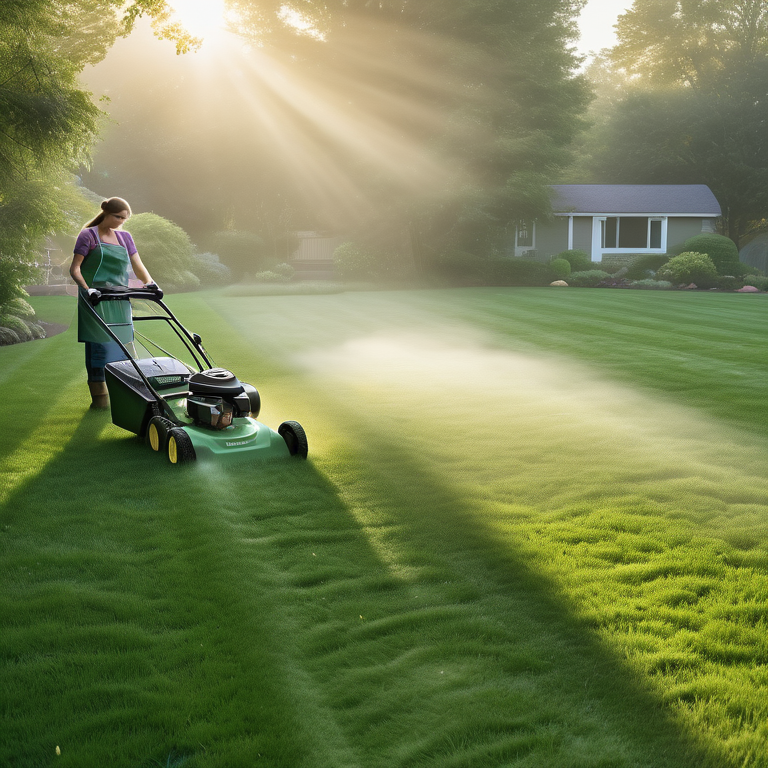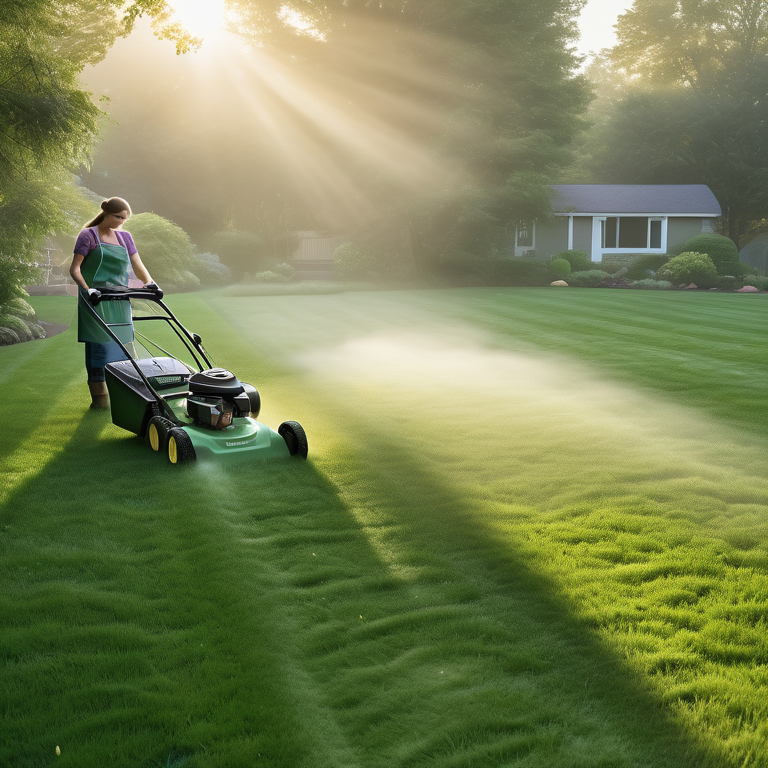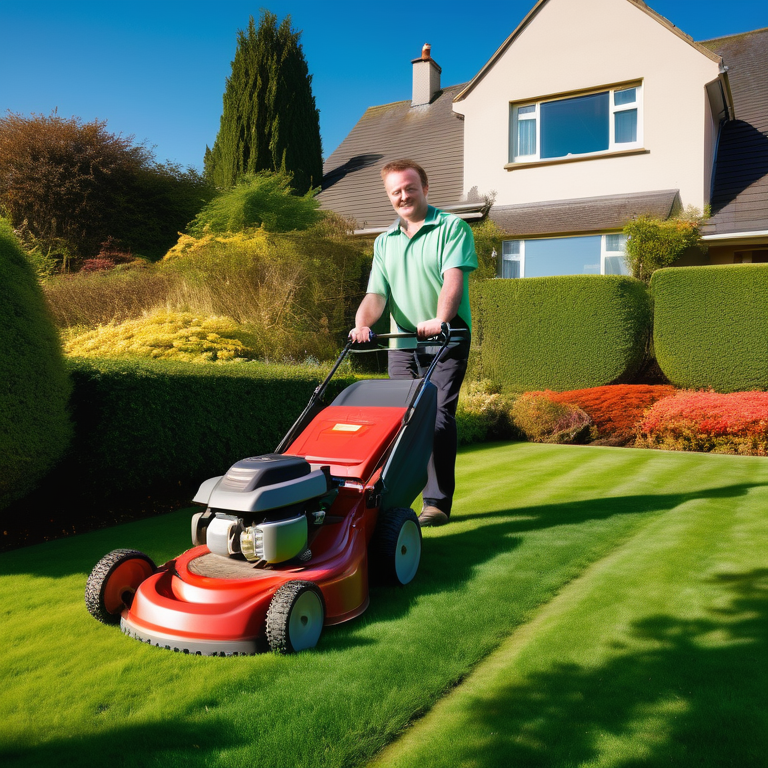Key Highlights
- Cutting wet grass can be risky and potentially damaging to your lawn mower due to the wet conditions and clumping of grass clippings.
- It is important to take necessary precautions and use the right tools, such as a sharp blade and a mower deck that is adjusted for wet conditions.
- Cutting wet grass can have long-term effects on the health of your lawn, including soil compaction and increased risk of fungal diseases.
- Safety measures should be taken when mowing in damp conditions, such as protecting yourself and your equipment from the wet conditions.
- Proper maintenance tips, including cleaning and storing your mower, are essential after cutting wet grass to prevent damage and promote lawn recovery.
- The key takeaway is to understand the risks and challenges of cutting wet grass and to follow best practices for a healthy and safe lawn care routine.
Introduction
Cutting the grass is a regular chore for many homeowners, but when the grass is wet, it can present a whole new set of challenges. Wet grass can be difficult to cut evenly and may clump together, causing potential damage to your lawn mower or strimmer. However, with the right techniques and precautions, you can master the art of cutting wet grass with a strimmer and maintain a healthy and beautiful lawn.
In this blog, we will explore the risks and challenges of cutting wet grass, understand the misconceptions surrounding mowing damp lawns, and provide a step-by-step guide to cutting wet grass effectively. We will also delve into the science behind wet grass cutting and discuss the impact of wet conditions on grass health. Additionally, we will provide safety measures for mowing in damp conditions and maintenance tips for post-wet grass cutting, including the potential downsides of cutting grass when it’s wet.
By the end of this blog, you will have a comprehensive understanding of how to safely and effectively cut wet grass, ensuring a well-maintained lawn even in wet conditions.
Understanding the Challenges of Cutting Wet Grass
Cutting wet grass comes with its own set of challenges. Wet conditions can make the grass clump together, resulting in an uneven cut and potentially damaging the lawn mower. Additionally, cutting wet grass can increase the risk of fungal diseases, as the moisture can create an ideal environment for fungi to thrive. Mowers are heavy machines and are not designed for use on soft, muddy ground, making it important to avoid cutting wet grass in these conditions. Understanding these challenges is crucial to ensure proper lawn care in wet conditions. www.wicklowlandscaping.ie
The risks involved in cutting wet grass
Cutting wet grass poses various risks, especially in wet weather or after heavy rainfall. One of the main risks is the potential for accidents due to slippery conditions, especially when operating a mower on uneven terrain. Walking across a wet lawn with a mower can lead to slips and falls, potentially causing injuries from contact with the mower blades. Moreover, wet grass clippings can stick to the lawn mower, impeding its performance and potentially clogging air inlets. It is important to be cautious and take necessary precautions to avoid accidents and ensure safe mowing in wet conditions. www.wicklowlandscaping.ie
Common misconceptions about mowing damp lawns
There are common misconceptions surrounding mowing damp lawns. Some people believe that mowing wet grass is ineffective and can damage the lawn mower. However, with the right techniques and tools, it is possible to achieve a clean and even cut on damp grass. Another misconception is the best time to mow wet grass. While it is generally advised to wait for the grass to dry, there are certain circumstances where mowing slightly damp grass can be acceptable. Understanding and debunking these misconceptions is important for proper lawn care in wet conditions.
Preparing to Cut Wet Grass
Before cutting wet grass, it is essential to prepare properly. This includes ensuring that your lawn mower is equipped with a sharp blade and a mower deck that is adjusted for wet conditions. A sharp blade will help achieve a cleaner cut, while an adjusted mower deck will prevent the grass from clumping together. Additionally, taking necessary precautions, such as wearing appropriate footwear and maintaining good posture while mowing, can help ensure safety and prevent accidents. It’s also a good idea to mow at a slower speed and avoid making sharp turns or sudden movements while mowing on wet grass. www.wicklowlandscaping.ie
Essential tools for cutting wet grass safely
To cut wet grass safely, there are a few essential tools to consider:
- A sharp blade: A sharp blade will ensure a clean and even cut, reducing the risk of damage to the grass and the lawn mower.
- A mower blade adjusted for wet conditions: Adjusting the mower blade to a higher setting can prevent the grass from clumping together and allow for better air circulation.
- Proper footwear: Wearing shoes with good traction and waterproof properties will help prevent slips and falls on wet grass.
- Protective clothing: Wearing appropriate clothing, such as long pants and gloves, can provide added protection while cutting wet grass.
Adjusting your mower for wet conditions
When cutting wet grass, it is important to adjust your mower for the wet conditions. One key adjustment is the mowing height. Raising the mowing height slightly can prevent the grass from getting too short, reducing the risk of damage to the lawn. Additionally, adjusting the mower deck to a higher setting of 3-4 inches can help prevent the grass from clumping together and allow for better air circulation. These adjustments will ensure a cleaner cut and promote the health of your wet lawn. www.wicklowlandscaping.ie
Step-by-Step Guide to Cutting Wet Grass
To effectively cut wet grass, follow this step-by-step guide:
- Prepare your lawn mower: Ensure that your mower is equipped with a sharp blade and a mower deck adjusted for wet conditions.
- Check the soil: If the soil is muddy or feels soft, it is best to wait for it to dry before mowing.
- Start with a higher mowing height: Adjust the mowing height to leave the grass slightly longer, reducing the risk of damage to the lawn.
- Mow in smaller sections: Mowing in smaller sections allows for better control and prevents clumping of wet grass clippings.
- Clean the mower as you go: Regularly remove wet grass clippings from the mower to prevent clogging and promote proper air circulation.
- Follow up with lawn care: After cutting wet grass, address any soil compaction issues by aerating the lawn and applying necessary fertilizers and nutrients.
When to decide it’s too wet to mow
While it is possible to cut wet grass, there are certain circumstances where it may be best to wait for the grass to dry. If there has been heavy rainfall or the grass is excessively wet, it is advisable to postpone mowing. Walking or pushing a mower on a saturated lawn can lead to compacted soil and potential damage to the grass roots. Similarly, if there is morning dew or the grass feels squishy underfoot, it is better to wait for the conditions to improve. Keeping an eye on the weather forecast and using your judgment based on the wetness of the lawn will help you determine when it’s too wet to mow, according to lawn expert David Hedges Gower. www.wicklowlandscaping.ie
Techniques for an effective wet grass cut
When cutting wet grass, there are techniques that can help ensure an effective cut:
- Mulching grass clippings: Mulching the grass clippings can help reduce clumping and provide natural nutrients to the lawn.
- Using an electric mower with a dry grass setting: Some electric mowers have a setting specifically designed for cutting wet grass. This can help prevent clumping and achieve a cleaner cut.
- Mowing dry patches first: If there are dry patches in the lawn, mowing them first can help prevent clumping of wet grass clippings and achieve a more even cut.
The Science Behind Wet Grass Cutting
Understanding the science behind wet grass cutting can help you make informed decisions about your lawn care. Wet conditions can affect the health of your lawn, particularly the grass roots. Compacted soil from mowing wet grass can hinder the absorption of water and nutrients, leading to poor grass growth. Additionally, wet weather can create an environment conducive to fungal diseases, which can further impact the health of your lawn. By considering these factors, you can develop a comprehensive lawn care routine that promotes the overall health of your lawn.www.wicklowlandscaping.ie
How wet conditions affect grass health
Wet conditions can have a significant impact on the health of your grass. Soil compaction from mowing wet grass can hinder the oxygen and nutrient exchange between the soil and grass roots. This can lead to poor grass growth and overall lawn health. Additionally, wet conditions create an ideal environment for fungal diseases to thrive, further compromising the health of the lawn. Understanding these effects can help you develop strategies to mitigate the impact of wet conditions on your grass, such as regular aeration to alleviate soil compaction and proper fungal disease prevention measures. www.wicklowlandscaping.ie
The impact of wet cutting on lawn quality
Cutting wet grass can have a negative impact on the quality of your lawn. Wet conditions can contribute to the spread of lawn diseases, as the moisture provides an ideal environment for fungi to thrive. This can result in patchy and discolored areas in your lawn. Additionally, wet grass clippings can leave behind grass stains on various surfaces, such as clothing, shoes, and driveways. Furthermore, cutting wet grass can lead to uneven and yellow grass due to clumping and poor mowing conditions. To maintain a healthy and vibrant lawn, it is important to consider the impact of wet cutting and take appropriate measures to prevent these issues.
Safety Measures for Mowing in Damp Conditions
Mowing in damp conditions requires extra caution and measures. When using an electric lawn mower, there is a higher risk of accidents due to the combination of wet conditions and electricity. It is important to take necessary precautions, such as wearing appropriate footwear and ensuring the mower is suitable for wet conditions. Wet shoes can also increase the risk of slips and falls. By following safety guidelines and using the right equipment, such as machinery specifically designed for wet conditions, you can mow your lawn safely in damp conditions. www.wicklowlandscaping.ie
Protecting yourself and your equipment
To protect yourself and your equipment when mowing in damp conditions, it is important to take necessary precautions. When using an electric mower, ensure that it is equipped with a ground fault circuit interrupter (GFCI) to prevent electric shock. Avoid mowing in wet conditions if possible, as it can increase the risk of accidents. Wear appropriate protective clothing, such as gloves and eye protection, to minimize the chances of injuries. Additionally, regularly inspect and maintain your mower to ensure it is in good working condition. By prioritizing safety and taking the necessary precautions, you can mow in damp conditions without compromising your well-being or damaging your equipment.
Electrical safety with corded and cordless mowers
When using corded or cordless electric lawn mowers in wet conditions, electrical safety is paramount. For corded mowers, ensure that the cord is properly grounded and in good condition. Avoid using extension cords in wet conditions, as this can increase the risk of electric shock. If using a cordless mower, ensure that the battery and connection points are dry before operation. It is important to follow the manufacturer’s instructions and adhere to safety guidelines to prevent accidents and ensure the safe use of electric lawn mowers in damp conditions. www.wicklowlandscaping.ie
Maintenance Tips for Post-Wet Grass Cutting
After cutting wet grass, proper maintenance is essential to keep your mower in good condition and promote lawn recovery. Cleaning the mower immediately after use will prevent grass clippings from sticking and clogging the equipment. It is also important to remove any wet grass clippings from the mower deck and air inlets to ensure proper air circulation. Storing the mower in a dry and secure location will prevent rust and damage from prolonged exposure to wet conditions. By following these maintenance tips, you can extend the lifespan of your mower and maintain a healthy lawn. www.wicklowlandscaping.ie
Cleaning and storing your mower
Proper cleaning and storage of your mower are crucial after cutting wet grass. Here are some steps to follow:
- Remove grass clippings: Use a broom or a blower to remove wet grass clippings from the mower, paying attention to the deck and air inlets. This will prevent clumping and clogging, ensuring proper airflow.
- Clean the mower deck: Use a brush or a scraper to remove any stuck-on grass clippings from the mower deck. This will prevent the buildup of moisture and potential rust.
- Inspect and lubricate moving parts: Check the mower for any signs of damage or wear and tear. Lubricate the moving parts, such as the wheels and the blade, to ensure smooth operation.
- Store in a dry location: Store the mower in a dry and secure location, such as a shed or a garage, to protect it from moisture and rust.
- By following these cleaning and storage practices, you can maintain the performance and longevity of your mower.
|
Column Name A |
Column Name B |
|
Remove grass clippings |
Use a broom or a blower to remove wet grass clippings from the mower |
|
Clean the mower deck |
Use a brush or a scraper to remove any stuck-on grass clippings from the mower deck |
|
Inspect and lubricate moving parts |
Check the mower for any signs of damage or wear and tear; lubricate the moving parts |
|
Store in a dry location |
Store the mower in a dry and secure location, such as a shed or a garage |
Lawn recovery after wet mowing
Proper lawn care is essential for the recovery of the lawn after wet mowing. Remove any grass cuttings or clumps left behind to prevent them from impeding the growth of the grass. Consider aerating the lawn to alleviate soil compaction and improve drainage. Applying necessary fertilizers and nutrients will promote healthy grass growth and aid in the recovery process. Additionally, monitoring the lawn for any signs of fungal diseases and taking appropriate measures, such as using fungicides, can help prevent further damage. By following these lawn care practices, you can ensure the recovery and health of your lawn after wet mowing.
Key Takeaways on Cutting Wet Grass
To summarize, cutting wet grass requires careful consideration and proper techniques. Here are the key takeaways:
- Cutting wet grass can be risky and potentially damaging to your lawn mower.
- Take necessary precautions, such as using a sharp blade and adjusting the mower deck for wet conditions.
- Wet conditions can impact the health of your lawn, including soil compaction and increased risk of fungal diseases.
- Follow safety measures to mow in damp conditions without compromising your well-being.
- Proper maintenance after cutting wet grass is essential for the longevity of your mower and lawn recovery.
- By following these best practices, you can master the art of cutting wet grass and maintain a healthy and beautiful lawn.
Summary of best practices
To summarize the best practices for cutting wet grass:
- It is generally advisable to avoid cutting wet grass if possible.
- If you must cut wet grass, ensure your mower has sharp cutting blades and is adjusted for wet conditions.
- Take necessary precautions to ensure your safety, such as wearing appropriate footwear and protective clothing.
- Clean your mower regularly to prevent clogging and promote proper air circulation.
- Store your mower in a dry location to prevent rust and damage.
- By following these best practices, you can effectively cut wet grass while minimizing the risks and maintaining the health of your lawn.
Highlighting www.wicklowlandscaping.ie expertise
At www.wicklowlandscaping.ie, we specialize in providing professional lawn care services. Our team of experts is experienced in handling wet grass cutting and can offer valuable advice and services to homeowners. We understand the challenges and risks involved in cutting wet grass and can provide expert guidance on best practices. Whether you need assistance with adjusting your mower for wet conditions or maintaining a healthy lawn after wet mowing, our team is here to help. Contact us today for professional lawn care services and homeowner tips on cutting wet grass. www.wicklowlandscaping.ie
Conclusion
In conclusion, mastering the art of cutting wet grass requires understanding the risks, misconceptions, and safety measures involved. By preparing with the right tools, adjusting your mower, and following effective techniques, you can achieve a well-maintained lawn even in damp conditions. Remember to prioritize safety and maintenance post-cutting to ensure the longevity of your equipment and the health of your grass. For more expert guidance on wet grass cutting and landscaping solutions, visit www.wicklowlandscaping.ie. Happy mowing! www.wicklowlandscaping.ie
Frequently Asked Questions
Is it ever safe to cut soaking wet grass?
Cutting soaking wet grass is generally not safe due to the increased risk of accidents and potential damage to the mower. It is advisable to wait for the grass to dry or to mow when the grass is only slightly damp.
How can I tell if my lawn is too wet for mowing?
You can determine if your lawn is too wet for mowing by checking the moisture level. If the grass feels squishy underfoot or if there is visible water or dew on the grass blades, it is best to wait for the lawn to dry before mowing.
What are the long-term effects of repeatedly cutting wet grass?
Repeatedly cutting wet grass can have long-term effects on the health of your lawn. It can lead to soil compaction, increased risk of fungal diseases, and damage to the grass roots, ultimately affecting the overall health of the lawn.
Can wet grass cutting contribute to lawn diseases?
Cutting wet grass can contribute to lawn diseases as the moisture creates an ideal environment for fungi to thrive. Wet grass clippings sticking to the mower blade can also spread fungal diseases to the lawn during subsequent mowing.










